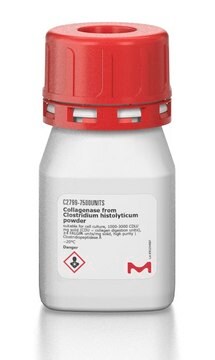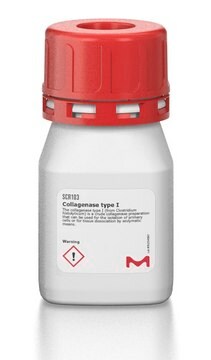C1889
Colagenase
0.2 μm filtered, suitable for release of physiologically active rat hepatocytes, Type IV-S, 0.5-5.0 FALGPA units/mg solid, ≥125 CDU/mg solid
Sinônimo(s):
Clostridiopeptidase A
About This Item
Produtos recomendados
Nível de qualidade
esterilidade
0.2 μm filtered
tipo
Type IV-S
forma
powder
atividade específica
≥125 CDU/mg solid
0.5-5.0 FALGPA units/mg solid
peso molecular
68-130 kDa
adequação
suitable for release of physiologically active rat hepatocytes
aplicação(ões)
diagnostic assay manufacturing
temperatura de armazenamento
−20°C
Procurando produtos similares? Visita Guia de comparação de produtos
Categorias relacionadas
Descrição geral
Aplicação
Ações bioquímicas/fisiológicas
Atenção
Definição da unidade
Nota de preparo
enzima
inibidor
substrato
Palavra indicadora
Danger
Frases de perigo
Declarações de precaução
Classificações de perigo
Eye Irrit. 2 - Resp. Sens. 1 - Skin Irrit. 2 - STOT SE 3
Órgãos-alvo
Respiratory system
Código de classe de armazenamento
11 - Combustible Solids
Classe de risco de água (WGK)
WGK 1
Ponto de fulgor (°F)
Not applicable
Ponto de fulgor (°C)
Not applicable
Equipamento de proteção individual
dust mask type N95 (US), Eyeshields, Faceshields, Gloves
Certificados de análise (COA)
Busque Certificados de análise (COA) digitando o Número do Lote do produto. Os números de lote e remessa podem ser encontrados no rótulo de um produto após a palavra “Lot” ou “Batch”.
Já possui este produto?
Encontre a documentação dos produtos que você adquiriu recentemente na biblioteca de documentos.
Os clientes também visualizaram
Nossa equipe de cientistas tem experiência em todas as áreas de pesquisa, incluindo Life Sciences, ciência de materiais, síntese química, cromatografia, química analítica e muitas outras.
Entre em contato com a assistência técnica










